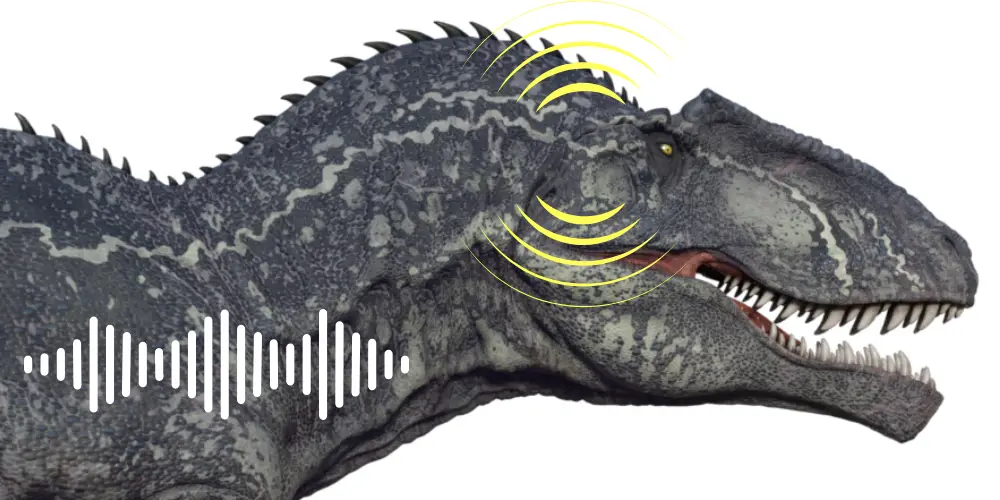The enigmatic world of dinosaurs has always been a subject of fascination and wonder.
One intriguing question often arises is, “Did dinosaurs have ears?”
This query piques our curiosity and holds significance in understanding the intricate physiology of these prehistoric giants.
Delving deeper into this question reveals some fascinating insights about their auditory capabilities.
Dinosaurs had ears, but not like mammals. Their auditory system was internal, with nerve canals in the skull connecting to the stapes, an inner ear bone. This setup ensured effective sound transmission, giving them a sharp sense of hearing without visible external ears.
Journey with us as we delve into the captivating world of dinosaur hearing.
Discover how these ancient behemoths sensed their environment and why their ears were perfectly tailored for their time.
Ready for a prehistoric sound trip? Let’s go!
Key Takeaways
- Dinosaurs had internal auditory systems, distinct from many modern animals.
- Their auditory structures included intricate nerve canals within their skulls.
- The stapes, an inner ear bone, played a crucial role in their hearing mechanism.
- Fossil records, like the skull of Sue the T. rex, provide evidence of their auditory capabilities.
- Unlike dinosaurs, many modern mammals have protruding external ears.
- Research suggests dinosaurs like Triceratops were adapted to hear low frequencies.
- Common misconceptions include the belief that dinosaurs had external ears akin to mammals.
- Online communities like Reddit have discussed and affirmed dinosaurs’ internal auditory systems.
- Dinosaurs’ hearing abilities were essential for communication, hunting, and survival.
- Understanding dinosaur auditory systems offers insights into their behaviors and lifestyles.
Dinosaur Ear Structure
The world of dinosaurs is filled with mysteries, and their auditory system is no exception.
Contrary to some popular misconceptions, dinosaurs were not deaf creatures roaming the prehistoric landscapes.
Their sophisticated ear structure allowed them to perceive sounds in their environment.
Dinosaurs indeed had ears, but they vastly differed from what we see in many animals today.
Their auditory structures were uniquely adapted to their needs and environment. Hidden within their massive and often intimidating skulls were intricate nerve canals.
These canals weren’t just random pathways but specifically designed to transmit auditory signals, allowing these ancient creatures to process sounds.
A standout feature of their auditory anatomy was the presence of inner ear bones. Among these bones, the stapes stood out.
This tiny yet significant bone was crucial to the dinosaurs’ hearing mechanism.
Acting as a bridge, the stapes transmitted vibrations from the outer ear to the inner ear, converting them into signals the brain could interpret.
While dinosaurs might not have had external ears flapping in the wind, their internal auditory system was a marvel of nature, ensuring they could hear and respond to the sounds of their prehistoric world.
Hearing Abilities of Dinosaurs
The world of dinosaurs was a cacophony of sounds, from the gentle rustling of ancient leaves to the thunderous roars of the mightiest predators.
Their remarkable auditory system was at the heart of their interaction with this soundscape.
The intricate design of the nerve canals, paired with the stapes, formed a sophisticated auditory mechanism that allowed dinosaurs to navigate their environment with precision.
The design and functionality of these components suggest that their auditory processing was advanced and fine-tuned.
Many paleontologists and researchers believe many dinosaur species possessed an acute sense of hearing.
This heightened auditory sensitivity was not just a luxury but a necessity.
In the dangerous landscapes they inhabited, detecting the faintest sounds could mean the difference between life and death.
Predators would rely on their hearing to stalk prey, while herbivores would use it to detect approaching threats.
Furthermore, communication was another vital aspect of their lives, where hearing played a pivotal role.
Whether it was a mother calling out to her offspring, a mating call, or a warning cry, the ability to both produce and interpret these sounds was essential for their social interactions and reproductive success.
In essence, the auditory capabilities of dinosaurs were not just about hearing but about survival, communication, and thriving in a world filled with challenges and opportunities.
Evidence from Fossil Record
The fossil record, a window into the ancient past, provides invaluable insights into the lives and capabilities of creatures that once roamed our planet.
Among the myriad discoveries that have shaped our understanding of prehistoric life, the auditory systems of dinosaurs stand out as a testament to their sensory abilities.
This record serves not just as a historical archive but as an indomitable testament to the auditory prowess of dinosaurs.
Each fossilized remnant tells a story, and in the case of dinosaurs, it often narrates tales of intricate hearing mechanisms that rival even some modern-day creatures.
A prime example that underscores this narrative is the well-preserved skull of Sue, one of the most complete Tyrannosaurus rex specimens ever discovered.
Sue’s skull is not just a testament to this apex predator’s sheer size and power but also its sensory capabilities.
The detailed auditory canals, visible even after millions of years, hint at a finely tuned creature to its surroundings.
Moreover, inner ear structures in such fossils further cemented the idea that these majestic beasts were not just mindless predators but creatures with advanced sensory tools.
Such discoveries, when pieced together, paint a vivid picture. They underscore that dinosaurs, far from being the lumbering giants of popular imagination, were well-equipped, sensory-wise, to interact with, understand, and dominate their environment.
The fossil record, in essence, serves as a silent witness to the auditory marvels of the prehistoric world.
Comparison with Modern Animals
Understanding the auditory structures of dinosaurs becomes even more intriguing when we draw parallels with modern-day animals. Here’s a comparative breakdown:
| Feature | Dinosaurs | Modern-Day Creatures |
|---|---|---|
| Ear Protrusion | Dinosaurs did not have protruding ears. | Many mammals, like humans, dogs, and elephants, have visible external ears. |
| Auditory Apparatus | Dinosaurs had the necessary internal structures for hearing. | Most animals today, from mammals to fish, have some auditory apparatus. |
| Closest Living Kin | N/A | Birds and reptiles are considered the closest living relatives of dinosaurs. |
| External Ears in Kin | N/A | Most birds and reptiles lack external ears, similar to dinosaurs. |
While dinosaurs were equipped with the necessary structures for hearing, their design was distinct from many creatures we see today.
One of the most notable differences is dinosaurs’ absence of protruding ears.
This feature is in stark contrast to many mammals that have external ears aiding in sound collection.
However, we observe a similarity when we look at birds and reptiles, the closest living kin of dinosaurs.
Like their ancient relatives, most birds and reptiles also lack external ears.
This observation suggests that the trait of protruding ears is predominantly unique to mammals, setting them apart in the animal kingdom’s auditory landscape.
Expert Opinions
Researchers used computed tomography (CT) to analyze Triceratops braincases and inner ear structures.
They found that Triceratops had a relatively short cochlear length, which suggests it was adapted to hearing low frequencies.
The study compared Triceratops to other dinosaurs and estimated that its best frequency of hearing was around 290 Hz, indicating sensitivity to lower-frequency sounds.
This adaptation might have allowed Triceratops to detect sounds from long distances.
The study provides valuable insights into the sensory capabilities of Triceratops and highlights the importance of inner ear morphology in understanding dinosaur ecology.
Debunking Misconceptions
When it comes to the auditory anatomy of dinosaurs, several misconceptions have taken root over time. Let’s address and debunk some of these myths:
- External Ears Myth: One widespread belief is that dinosaurs had external ears similar to mammals. This image might be influenced by popular culture or simple misunderstandings.
- Reality: Dinosaurs did not have protruding ears. Their auditory structures were entirely internal.
- Comparison with Mammals: Due to the prominence of mammals in today’s world, it’s easy to assume that most creatures, including dinosaurs, had similar auditory features.
- Reality: Dinosaurs’ auditory systems were distinct from mammals. While mammals often have external ear flaps aiding in the sound collection, dinosaurs lacked such features.
- Dinosaur Hearing Abilities: Some might think that the absence of visible ears meant dinosaurs had poor hearing.
- Reality: Despite lacking external ears, many dinosaur species had an acute sense of hearing, thanks to their intricate internal auditory structures.
By understanding and debunking these misconceptions, we can appreciate dinosaurs’ unique and sophisticated auditory systems, setting them apart from many of the creatures we’re familiar with today.
Community Opinions
The digital age has given rise to numerous online communities where enthusiasts, experts, and curious minds converge to discuss a myriad of topics, including the auditory capabilities of dinosaurs.
Platforms like Reddit have become hotbeds for such discussions, offering scientific insights and personal opinions.
- Reddit Discussions: Subreddits dedicated to paleontology and dinosaurs often feature threads discussing the anatomy of these prehistoric giants. Many users share articles, research papers, and personal insights to illuminate the topic.
- Key Takeaway: A prevalent sentiment among Reddit users is the acknowledgment that dinosaurs did not have external ears like many mammals do today. Instead, their auditory mechanisms were more internalized and sophisticated in their own right.
- Community Consensus: While individual opinions might vary, a general consensus emerging from these discussions is understanding the uniqueness of mammalian external ear structures.
- Key Insight: The community largely agrees that dinosaurs, with their distinct anatomy, had internal auditory systems that set them apart from the mammals we’re familiar with.
Value of Community Discussions: These online discussions provide a platform for knowledge exchange and highlight the collective curiosity and passion for understanding the natural world. They testify to the ever-evolving nature of scientific understanding and public interest.
Online communities have played a pivotal role in democratizing knowledge, allowing for a more holistic understanding of topics like dinosaurs’ auditory capabilities shaped by expert insights and public discourse.
Final Thoughts
Dinosaurs, those colossal beings that once roamed our planet, have always been enveloped in a shroud of mystery and awe.
Among the many facets of their existence, their auditory capabilities stand out as a testament to nature’s intricate design.
While they didn’t possess ears like many modern creatures, their internal auditory systems were perfectly tailored to their needs.
This unique configuration made them perceive their surroundings precisely and was pivotal in their communication, hunting, and survival strategies.
As we unravel these auditory mysteries, we are satisfying our age-old curiosities and gaining profound insights into the behaviors and lifestyles of these magnificent prehistoric creatures.
Every revelation about their hearing abilities adds a vibrant stroke to our portrait of dinosaur biology.
REFERENCES:
- National Geographic. (2021, June 5). Dinosaur skull scans reveal clues about flight—and communication. https://www.nationalgeographic.com/science/article/dinosaur-skull-scans-reveal-clues-about-flight-and-communication
- Bhullar, B.-A. S., Marugán-Lobón, J., Racimo, F., Bever, G. S., Rowe, T. B., Norell, M. A., & Abzhanov, A. (2012). The early origin of a birdlike inner ear and the evolution of dinosaurian movement and vocalization. NSF PAR. https://par.nsf.gov/servlets/purl/10332226
- Horowitz, R. (2010). Articulating Dinosaurs: Ethnography Chapters 8-13, “Articulating Maiasaura, The Good Mother Lizard” (selections-2). ResearchGate. https://www.researchgate.net/publication/356174893_Articulating_Dinosaurs_Ethnography_Chapters_8-13_Articulating_Maiasaura_The_Good_Mother_Lizard_selections-2



